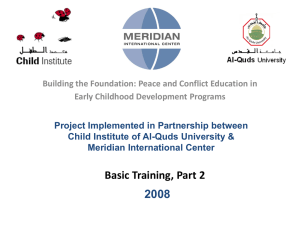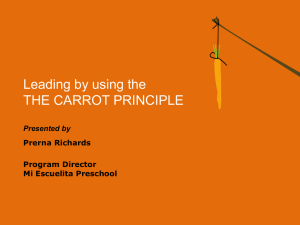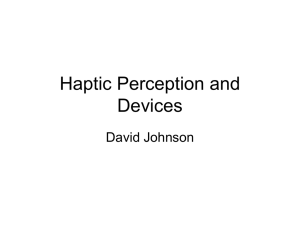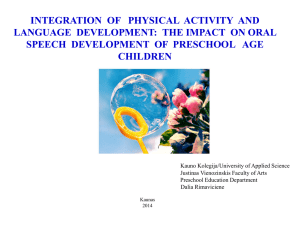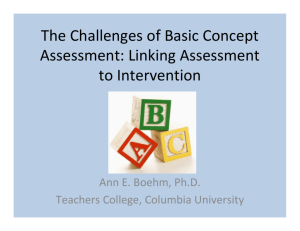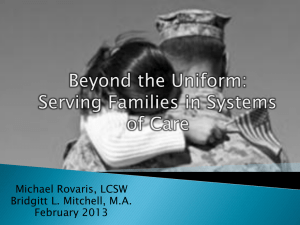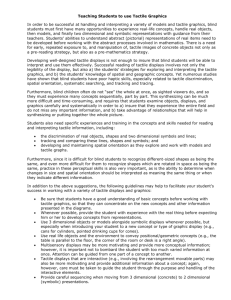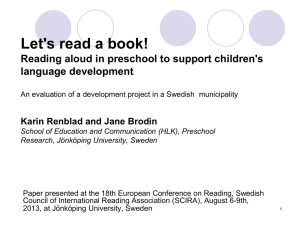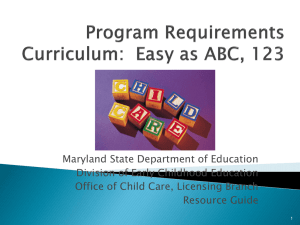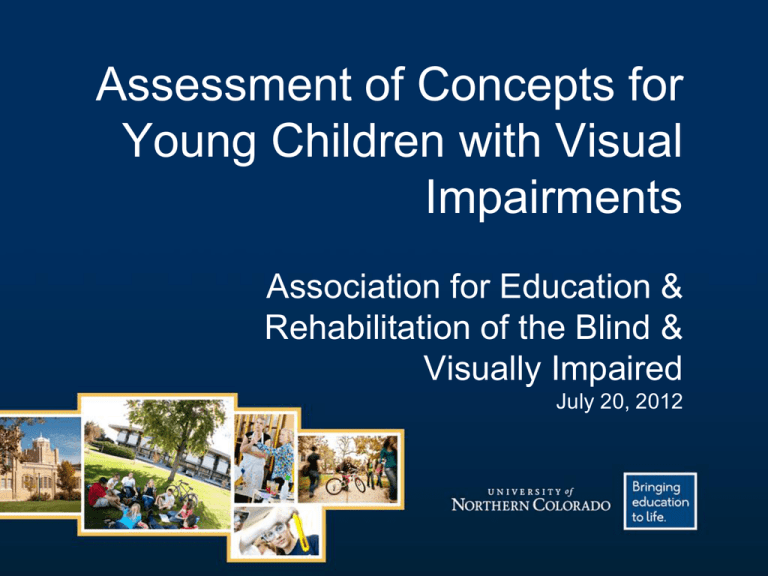
Assessment of Concepts for
Young Children with Visual
Impairments
Association for Education &
Rehabilitation of the Blind &
Visually Impaired
July 20, 2012
PLEASE NOTE:
All videos have been removed from this
presentation to honor confidentiality
agreements with families.
Images from the original Boehm-3 Preschool
have also been removed to preserve the
integrity of the test.
Tactile Adaptation of the
Boehm-3 Preschool
Boehm Test of Basic Concepts, Third Edition
Preschool (Boehm-3 Preschool). Copyright
©2001 NCS Pearson, Inc. Braille adaptation
copyright ©2011 NCS Pearson, Inc. Adapted and
reproduced with permission. All rights reserved.
Developed by the
American Printing House
for the Blind
with special thanks to Barbara Henderson
and Ann Boehm
and with permission of
Pearson, Inc.
The Importance of Choosing the
Boehm-3 Preschool
• History of tactile adaptation of school-age
Boehm
•
•
Tactile Test of Basic Concepts
Hilda Caton, 1967
• Can be individually administered to children
ages 3 years 0 months to 5 years 11 months
Importance, continued
• Assesses young children’s understanding of
basic relational concepts:
− Important for language and cognitive
development.
− Linked to academic success in school
− Understanding of directions and classroom
routines.
− Critical aspect of emerging literacy.
Ferrell (1998, 2011); Dunst & Gorman (2011)
Technical Construction
Boehm-3 Preschool
• Downward extension of the Boehm Test of
Basic Concepts (BTBC) (Boehm, 1971)
• 660 children, ages 3-0 to 5-11 years
• Stratified by age, gender, race/ethnicity, parent
education level, geographic region to replicate
the US population
Technical Construction, continued
• Internal consistency: .85 to .92
• Test-retest reliability: .90 to .94
• Content validity:
– Correlation with Boehm Preschool = .84
– Correlation with Bracken Basic Concepts
Scale-Revised = .80 (3-year-olds) and .73
(5-year-olds)
Prototype Development: What
does Recent Haptic Research
Show?
• Limit number of symbols to three or less to
address cognitive load concerns
(Spence & Gallace, 2007)
– Original Boehm-3 Preschool included four
stimuli for each item to reduce possibility
of guessing.
– An equal number of test items with three
or four stimuli were randomly assigned for
field test.
Pilot Study Results:
Three vs. Four Stimuli
% Passing 33 vs. 4 stimuli
items
n = 12
0.829%
% Passing 4items
0.748%
• Although more participants passed the 3-item
stimuli, there was no significant difference.
• Majority of teachers preferred 4-stimuli.
• Retaining both 3- and 4-stimuli items.
Prototype Development: What
does Recent Haptic Research
Show?
• Preliminary studies with young children with
visual impairment show that:
– Both hands move together in synchrony
– The hands show a preference for textures that
are increasingly dense
– Once a complex texture is found, movement
patterns are slowed for further exploration
Schellingerhout, Smitsman, & Cox (2005)
Pilot Study Results: Both Hands
Move in Synchrony
• Qualitative video evidence indicates that twohanded tactile scanning is not required to
discriminate concepts or test items.
• Most subjects favored one hand or the other to
explore items.
− High-level tactile skills do not appear to be related to
concept understanding for this age range.
Pilot Study Results: Preference
for Dense Textures
Yes, subjects
show a marked
preference for
stimuli with
texture, or beads:
Pilot Study Results: Complex
Textures Slow Movement
• Further research with a larger sample necessary
• “Familiarity” rather than “complexity” seems related
to speed of understanding
• Concerted effort to replicate everyday stimuli (such
as zippers, spoons, buttons, bead strings, etc.), to
encourage child to attend to concept being
measured.
• Engagement also a factor (gingerbread cookie).
Decker, 2010; Spence & Gallace, 2007.
Bead Strings Create Good
Discrimination Even When
Fatigue Sets In . . . .
Prototype Development: What
does Recent Haptic Research
Show?
• Additional Issues:
• If distractors are significantly different from each
other, focus remains on the concept (Pathak & Pring,
1989)
• Size of stimuli affects task time (Berla, 1972; Millar, 1978)
• Appropriateness of age-bands for tactile assessment
• 4-6 age range was the only group that displayed significant
difficulty in mastery of the tactile perceptual functioning skills
on the Tactual Profile (Withagen, Mathijs, Janssen, Knoors, &
Verhoeven, 2010)
Pilot Study Results: Stars and
Buttons are Good “Distractor”
Combinations
Teacher Feedback
• Stimuli appropriate for children with low
vision, blindness, multiple disabilities, learning
disabilities
• Favorite items: Gingerbread cookies, stars,
zippers, spoons
• Not-so-favorite: Boxes around groups of
objects, arrows
[Original test item in this position
removed]
Pilot Study Results: AgeAppropriate Items
Age
n = 12
Percent Passing
3 year olds 4 & 5 year olds
0.875%
0.948%
Preliminary data indicate that the tactile
version of the Boehm-3 Preschool shows
developmental progress across age
ranges.
Next Steps
• Tactile and large print adaptations of Boehm
Test of Basic Concepts, Third Edition (Boehm3) (2000) for Kindergarten – Third Grade
• Grant proposal to validate tactile and large
print analogs to Boehm-3 Preschool
• Phenomenological study of how teachers of
students with visual impairment teach basic
concepts to preschool children
Kay Alicyn Ferrell, Ph.D.
University of Northern Colorado
kay.ferrell@unco.edu

